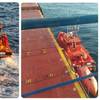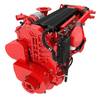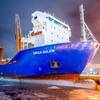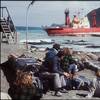Houston-based Kirby Inland Marine has a fleet of 215 tugboats and 911 tank barges, the largest operator of its type in the country with about one-third of the total tank barge tonnage in the US. Its total transport capacity corresponds to 16.6 million barrels. Kirby is in the midst of re-engining its fleet and the new engines being installed are from Volvo Penta. Volvo Penta has delivered slightly less than 100 engines to date in sizes from 5 to 34 litres cylinder volume to boats in Kirby's fleet. More than 40 of the engines delivered are for powering the tugboats. These engines operate under tough conditions, in which each boat pushes a line of connected barges, in temperatures that are often 40 degrees C in the air and 25 in the water. However, perhaps the heaviest demand is placed on the environmental properties of the engines. Previously, Kirby's boats were often propelled by two-stroke diesel engines. "Our demands were that the new engines must deliver better economy, higher performance and lower exhaust emissions and we received this from Volvo Penta," said John Sansing, Vice President Maintenance, at Kirby Inland Marine. The cooperation with Kirby represents a breakthrough for Volvo Penta in a highly important segment. "With our engine program of 100 to 2,000 hp, we have engines that are especially suitable for virtually all boats in inland waterway and canal traffic. This is a very large market, particularly in the US," says Bertil Börjesson, Strategy Manager for Volvo Penta's Marine Commercial operations.
Revitalizing Kuwaiti Workboats
Volvo Penta recently equipped two Kuwaiti workboats, a pilot boat and a buoy layer, with twin 34-liter diesel engines. Both vessels, which have been laid-up since the invasion by Iraq in the beginning of the 1990s, are now in service in the Kuwait City harbor. The rebuilt boats, M/V Muwasalat and M/V Mursheed, are owned by the Kuwait Port Authority and are operated by Naseb Maritime Company. Direct from the start, the demands placed on the work and material were high.
M/V Muwasalat is a 300-ton buoy layer equipped with a 25-ton bow crane. The ship was built in 1977 at a Japanese shipyard and was originally equipped with two MTU 8V396 diesel engines, each with 680 hp. Until the Iraqi invasion of Kuwait in 1990, the vessel served as a buoy layer and maintenance ship. Thereafter, the ship in principle has been laid up until on a commission from the Kuwait Port Authority it has now been refurbished and again placed in operation.
Two Volvo Penta D34s, each at 634 kW, were selected as the new propulsion system for the ship. Combined with two Voith Schneider units, they propel the 300-ton ship at a speed of 12 knots.
A fire pump is located on the front of the port engine, while the starboard engine is linked to an axle generator. The control system is a Rudolf 1, with slave panels on the bridge. M/V Mursheed is a 70-ton pilot boat that operated in the Kuwait City harbor until 1990. The vessel's original propulsion machinery was replaced with two Volvo Penta D34s, each with 701 kW, connected to two ZF1900A transmissions with 2.0:1 gearing. Combined, they power the pilot boat at a speed of 18 knots.
December 2024
 Read the Magazine
Read the Magazine

 Read the Magazine
Read the Magazine
This issue sponsored by:

Propulsion Choices begin with Fuel and End with Politics
Subscribe for
Maritime Reporter E-News
Maritime Reporter E-News is the maritime industry's largest circulation and most authoritative ENews Service, delivered to your Email five times per week










